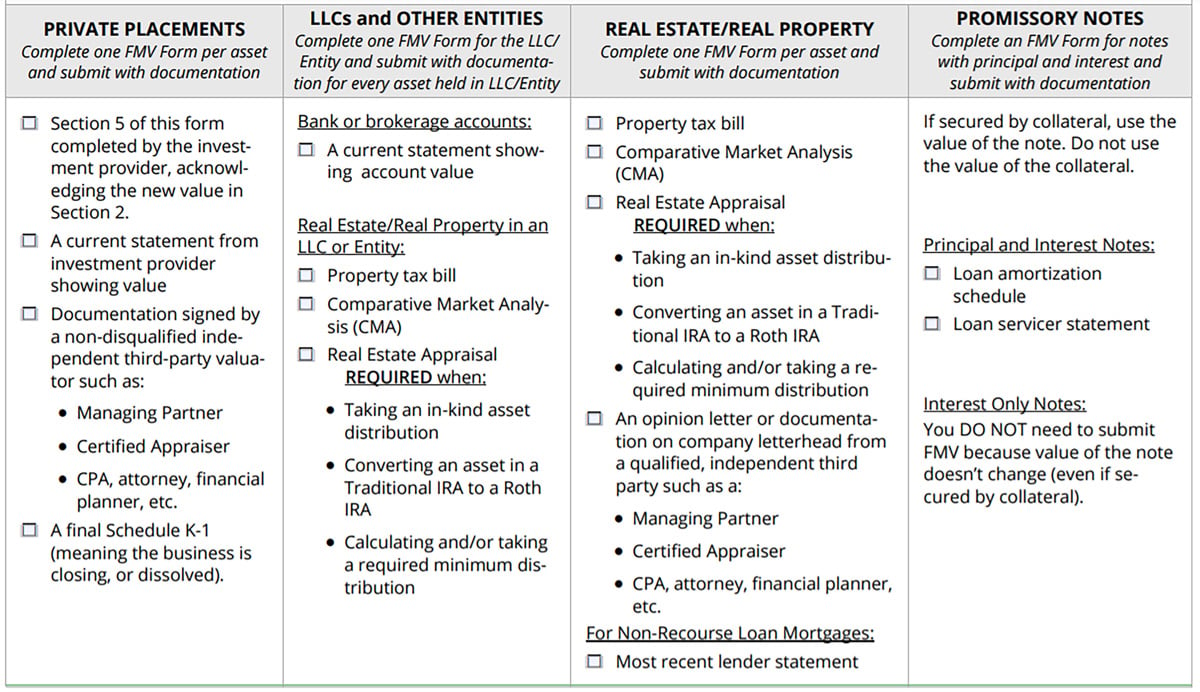How to Properly Report Fair Market Value (FMV) of Self-Directed IRAs

If you have a self-directed IRA, at end of the year you'll receive a notice from your IRA custodian requesting you update the value of the assets in your account. This is called a “Fair Market Valuation” (or FMV) and it is used to adjust the value of an asset in your account— and with that, the total value of your IRA.
The Basics of Fair Market Valuations
The fair market value of an account is the market value of each asset held in your self-directed IRA, based on what a willing and informed buyer would pay a willing and informed seller.
This yearly estimate is mandatory for most assets. However, some assets do not require this valuation (such as precious metals, publicly traded securities, and cash) because these investment values can be easily determined by the market.
A fair market valuation is also required when:
- Taking an in-kind asset distribution
- Converting an asset to a Roth IRA
In all the transactions listed above, the value for the IRA will change. Therefore, a new value is required to be reported to the IRS determining the IRA’s worth.
Regardless of the amount that you are submitting as the fair market value of the account, you must provide supporting documentation for the value. See the image below for what is acceptable.
Examples:
FMV and Required Minimum Distributions (RMDs)
The fair market value of an IRA is very important for individuals who need to take Required Minimum Distributions (RMDs) because the IRA value is used to help calculate the RMD amount.
Using a Valuator to Properly Report the Fair Market Value of the Assets
A FMV is an estimate of the market value of an asset, based on what a knowledgeable, willing, and unpressured buyer would probably pay to a knowledgeable, willing, and unpressured seller in the current market. Therefore, to properly report the FMV of an asset, a qualified, independent third party should perform the valuation and provide supporting documentation. You should never use a disqualified person to do the valuation.
A qualified, independent third-party valuator may be a:
- Managing Partner in the case of an LLC, LP, or Entity
- Certified Appraiser
- Licensed Real Estate Professional (such as a broker/real estate agent)
- Knowledgeable Party (such as a CPA, attorney, financial planner, etc. who is strictly at “arm’s length” from both you and the investment)
- Independent Valuation Company
When a valuation is required the payment for the service must come from the IRA that made the investment. If your account does not have sufficient undirected cash to cover the cost, you will have to make an annual contribution, transfer, or rollover funds from another custodian to pay for the valuation services.
How to Value an LLC, Entity, or Private Placement in a Self-Directed IRA
To provide accurate value for your LLC or entity in your IRA, you must value each asset within in the limited liability company (LLC) or entity to determine the whole value of the IRA investment, minus any liabilities. Real estate assets owned in an LLC or entity should be evaluated by a third party. See the real estate section below. For other assets in the LLC or entity, such as bank or brokerage accounts, you can use the year-end statements proving their value.
If you are an IRAR Trust client and we are already receiving year-end statements, you do not need to submit an FMV. Verify with the investment provider that they are sending statements to IRA Resources and that the value is accurate, then your work is done.
For private placements, the value of the asset may be provided by a qualified third party. They must provide sufficient supporting documents along with the Fair Market Valuation Form for it to be accepted. For example, with private stock you can use recent offers to purchase (if any) or the formula to value it in the arm’s length shareholder agreement, if applicable. A K-1 can be submitted only if the business is closing or dissolved.
Reporting a Worthless Asset in an LLC, Entity, or Private Placement
To change the status and value of a worthless asset in an LLC, entity, or private placement, you must provide the necessary documentation that will support the status and value, as listed below. You will not need a qualified, independent third party to perform the valuation. You can complete the Fair Market Valuation Form and provide supporting documentation showing the asset is worthless.
To update the value and remove the worthless asset(s) from your account, there are specific types of documentation needed. The following are some acceptable examples of documentation for a worthless asset that IRA Resource accepts:
- Bankruptcy/Receivership Paperwork
- A “cease and desist order” from an entity such as the SEC or a similar state agency.
Relevant: Self-Directed IRAs: Rules you Need to Know to Protect your Account
How to Value Real Estate in your IRA
If you hold real estate in your self-directed IRA, in non-taxable situations, IRA Resources accepts the following documents to prove the value of the asset:
Property Tax Bill
This is accepted as long as it is not used to calculate or take an RMD. If you are taking an RMD you are required to provide a real estate appraisal.
Comparative Market Analysis (CMA)
A CMA is a detailed report examining the homes currently on the market, under contract, recently sold and recently expired, withdrawn, or canceled to determine what a property is worth in the current market. A licensed real estate professional, who is strictly at “arm’s length” from both you (the account owner) and the investment, can provide the CMA.
Opinion Letter
You may provide an opinion letter on company letterhead from a qualified, independent third party. See list of qualified valuators listed above.
Real Estate Appraisal
You can submit an appraisal, but it is not required if you can provide any of the other documents listed above. However, an appraisal is required when:
- Calculation or taking an RMD
- Taking an in-kind asset distribution
- Converting an asset to a Roth
Reporting a Worthless Real Estate Asset
If your real estate holds no value, indicate the status and value on the FMV Form, then sign it yourself. Provide the necessary documentation (examples below) that will support the status and value. You will not need a qualified, independent third party to perform the valuation.
To remove the real estate asset from your account, we require some supporting documentation.
The following are some acceptable examples of documentation that IRA Resources accepts for a worthless real estate asset:
- Deed in Lieu of Foreclosure or a copy of the recorded Trustee’s Deed (for a defaulted mortgage)
- County’s recorded Tax Deed (for defaulted property taxes)
What Happens if I do not Provide a Fair Market Valuation for my Assets?
You are required to report the most current FMV available for the investment(s) in your account at least once a year. If IRAR does not receive the Fair Market Valuation Form, the last known value of the assets in your account will be reported to the IRS. The IRS uses this information to set RMDs for those account holders over the age of 70 ½ with traditional IRAs and for taxable events. For example, converting a traditional IRA to a Roth (or a specific investment in the account) from a traditional IRA to a Roth IRA would be a taxable event.
If you need additional information on how to complete an FMV, please give our self-directed IRA experts a call. One of our representatives would be happy to walk you through the process. Happy investing!
Fair Market Value FAQs
What is the fair market value of an account?
The fair market value of an account is the market value of each asset held in your self-directed IRA, based on what a willing and informed buyer would pay a willing and informed seller.
Why is the FMV of an account needed?
A FMV is needed to update the value of the assets in your account. This is called a “Fair Market Valuation” (or FMV) and it is used to adjust the value of an asset in your account— and with that, the total value of your IRA.
How do I determine the FMV of my IRA?
To determine the fair market value of your IRA, you must first determine the value of each asset in the IRA. Depending on the assets (as listed above) you will need to submit supporting documentation proving the value of the asset.








Comments (10)